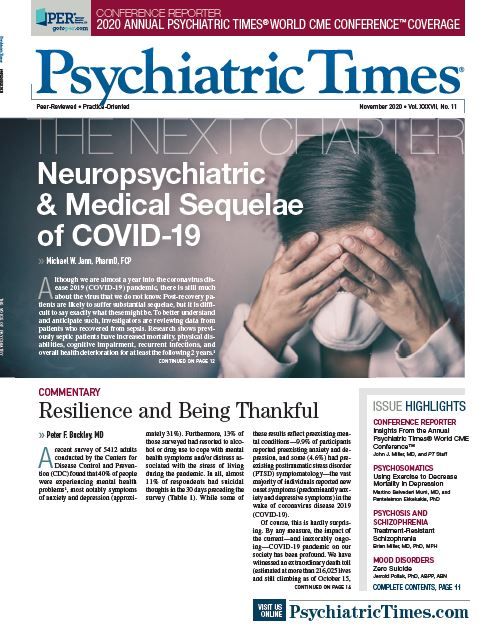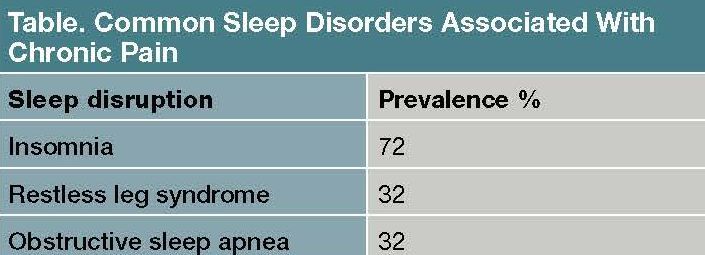Publication
Article
Psychiatric Times
Sleep Disturbances as a Sequalae of Chronic Pain
Author(s):
Sleep disturbance and chronic pain work together to cause misery for patients, with one exacerbating the other. Here: Tips to address both and bring peace to patients.
KevinCarden/AdobeStock

SPECIAL REPORT: PAIN & PSYCHIATRY
Pain has a substantial impact on sleep, and an insufficient amount of restful sleep can increase pain susceptibility. Brief bouts of pain—such as pain due to a traumatic injury or a short-lived medical issue—can cause almost immediate adverse effects on daytime functioning and alertness. The symptoms can begin to manifest as soon as the day after a night of inadequate sleep. Chronic pain can lead to prolonged sleep deprivation that can have physical, emotional, and behavioral complications. For example, in the rheumatologic literature, it has long been noted that there is an association between chronic musculoskeletal pain, sleep disruption, and depression.1 More recent research attempts to elucidate the contributing factors and address treatment planning.
Restorative sleep is a benefit of effective pain management. A pain management strategy may also require dedicated attention to sleep quality and sleep quantity. Evaluation of sleep disturbances in the context of chronic pain requires a comprehensive assessment of subjective symptoms and objective tests, such as sleep questionnaires and an overnight polysomnogram. Treatment of sleep issues caused by chronic pain is individualized and multifaceted and must take the chronic pain condition, the specific sleep disturbance, and the psychiatric sequalae into account.
Sleep disturbances caused by chronic pain
It is estimated that between 50% to 80% of those living with chronic pain experience sleep disruption. For example, a study revealed 53% of participants with chronic pain met criteria for insomnia, while only 3% of the pain-free controls met the criteria.2 There is also a potential a dose-response link between the intensity of pain and its impact on sleep.
Insomnia is the most commonly noted sleep disorder associated with chronic pain. A large meta-analysis noted a high prevalence of other sleep disruptions as well, with the 3 most common being insomnia at 72%, restless leg syndrome with a prevalence of 32%, and obstructive sleep apnea with a prevalence of 32%.3 It is notable that the 3 most commonly observed sleep disorders added up to greater than 100%, underscoring the fact that chronic pain can be associated with more than 1 type of sleep disturbance at a time (Table).
How pain impacts sleep
There are several mechanisms by which pain interferes with sleep. Pain is an obvious distraction that makes it hard to fall asleep and can lead to waking up at night, especially when pain medication wears off. However, pain also interferes with the physiology of sleep in targeted ways that go beyond the conscious distraction caused by the discomfort. There is a variability in chronic pain diagnoses, and the distinctive types of pain syndromes affect sleep differently. Furthermore, the impact of chronic pain on sleep appears to be multidimensional. Research into various pain syndromes and their physiological impact on sleep provide a range of insights into the ways that pain interferes with sleep.
For example, acute post-surgical pain also has quantifiable effects on sleep, including a measurable decrease in the time spent in the rapid eye movement phase (REM) of sleep. Changes are noted not only after general anesthesia, but also after regional anesthesia.4 This observation suggests that the pain itself (rather than the general anesthetic wearing off) is at least a contributing factor to post-operative pain-associated sleep disturbances.
Fibromyalgia is frequently associated with sleep disturbances.1 Patients with fibromyalgia have reduced short-wave sleep and abnormal α-rhythms, with episodes of wakefulness during non-REM sleep.5 Daytime fatigue and non-restorative sleep are common complaints among patients who have fibromyalgia, and these polysomnogram findings are consistent with inadequate sleep quality, even when patients might seem to have slept for an adequate number of hours.
Neuropathic pain is also associated with sleep disturbances, and there is a strong bidirectional relationship between sleep disturbances and neuropathic features of pain.6
Sleep disturbances are common among patients who have chronic, recurrent headaches. Common headache types, including tension headaches and migraines, often have associated symptoms besides pain, including sleep disturbances.7 As with fibromyalgia, the amount of time spent sleeping is not necessarily diminished in patients who have headache-associated sleep disturbances. Instead, it is the restorative effects of sleep that are impacted by chronic headache pain, rather than the total amount of sleep per night. The features of sleep disturbances can also vary with different types of headaches.7
Sleep deprivation and pain
Sleep disturbance also can affect a person’s response to pain. As sleep stages are compromised, daytime pain increases through a process of hyperalgesia, in which lower pain stimuli result in higher pain perception and greater pain-associated impairment than would be expected otherwise.8
According to research in patients with fibromyalgia, sleep deprivation impairs pain-inhibition pathways that normally help control pain.5 Studies also suggest that sleep deprivation can lead to systemic inflammation that can amplify pain.2 The evidence does not suggest that sleep deprivation can independently cause pain; rather, sleep deprivation may amplify the perception of pain that is already occurring as a result of underlying causes.
It is important to note that, while there is a strong association between sleep disorders and chronic pain and mood disorders, it is very difficult to determine which of these has a stronger impact on the others.3
Psychiatric consequences of pain-related sleep disturbances
A number of psychiatric sequelae can complicate pain-induced sleep disturbances. There is a strong relationship between chronic pain that is associated with sleep disturbances and subsequent diagnoses of depression and anxiety.2 Other psychiatric issues, such as delusions, hallucinations, or mania are not commonly noted with pain-induced sleep disturbances.
Studies looking at neuropathic pain suggest that inflammation may be associated with psychiatric changes and behavioral alterations.6 However, experts are not completely sure whether there may be other contributory factors as well, and future research regarding the etiology of psychiatric disturbances in pain-induced sleep disturbances may answer some of the currently unanswered questions about these complex relationships.
Regardless of the exact molecular cause, psychiatric diagnoses of anxiety or depression can cause severe patient distress and may also lead to behavioral changes. These issues must be addressed in the clinical setting so that patients can have access to symptom relief and an improved quality of life.
Assessment and treatment strategies
Because of the bidirectional relationship between pain and sleep disturbances, experts recommend evaluating patients who have chronic pain for undiagnosed sleep disorders.3 Evaluation can include commonly used sleep questionnaires, such as the Mini Sleep Questionnaire (MSQ), the Pittsburgh Sleep Quality Index (PSQI), and the Epworth Sleepiness Scale. Objective measures include polysomnogram, Multiple Sleep Latency Test (MSLT), and Maintenance of Wakefulness Test (MWT). Additionally, screening tests for depression and anxiety are often necessary as well. Key components of the evaluation include diagnosing the sequelae of pain in addition to diagnosing the pain syndrome.
The treatment of pain has far reaching effects beyond pain control. Yet, managing pain-related sleep disturbance is not based on pain management alone. Interventions directly aimed at treating sleep disturbance are associated with a better outcome than interventions aimed at only treating the pain.2
Currently, very little research has been done on the optimal treatment of sleep disorders in patients with chronic pain, and there is a lack of formal guidelines for approaching the problem. Research is emerging, however, and some experts recommend tailoring sleep care to the specific patient, rather than using a general approach to managing sleep disturbances for patients in whom chronic pain is believed to be the cause of the sleep problem.9 Some authors even suggest that chronic pain is a triad that includes pain, sleep disturbance, and depression.10
There are a number of different treatment approaches for pain-associated sleep disturbances, including cognitive behavioral therapy, medication, and respiratory support during sleep for patients who need it.11 Treatment of chronic pain should always take sleep issues into consideration. Opioids, for instance, can alter sleep architecture, and while there are many disadvantages to long-term use of opioids for treating chronic pain, there are rare situations in which they are prescribed. This treatment can be especially problematic for patients who have respiratory sleep disorders, like sleep apnea. Given the complicated balance involved in chronic pain management, opioids might still be an appropriate part of the treatment plan for certain patients who have respiratory side effects. In these cases, the use of respiratory assistance, such as continuous positive airways pressure (CPAP) during sleep, may be an effective solution.9
The overall approach to pain management that is complicated by sleep and psychiatric issues requires a tailored plan. It might or might not involve treatments for more than 1 diagnosis of the pain/sleep disturbance/depression triad. For instance, antidepressants might help with pain control and with mood stabilization. And anticonvulsants may help with pain control while also improving sleep.10 But, despite these obvious potential overlaps in treatment, some patients might benefit from optimal treatment approaches tailored to each diagnosis, even if completely separate treatments for each condition are required to achieve control of symptoms. Pharmacological interventions often must be selected based on the targeted symptoms. Even conservative management approaches, such as counseling, cognitive behavioral therapy, and physical therapy are most effective when they are symptom-specific, because the conservative approaches for treating each condition are not identical.11
Dr Moawad is Associate Editor Humanities in Neurology, Clinical Assistant Professor Case Western Reserve University School of Medicine, Div. of Medical Education, and Editor in Chief Emeritus of Neurology Times (2017-2019).
This article was originally posted on September 21, 2020, and has since been updated. Scroll down for the PDF of the full print issue in which it appeared. -Ed
References
1. Moldofsky H. The significance of the sleeping-waking brain for the understanding of widespread musculoskeletal pain and fatigue in fibromyalgia syndrome and allied syndromes. Joint Bone Spine. 2008;75(4):397-402.
2. Cheatle MD, Foster S, Pinkett A, et al. Assessing and Managing Sleep Disturbance in Patients with Chronic Pain. Anesthesiol Clin. 2016;34(2):379-393.
3. Mathias JL, Cant ML, Burke ALJ. Sleep disturbances and sleep disorders in adults living with chronic pain: a meta-analysis. Sleep Med. 2018;52:198-210.
4. Dette F, Cassel W, Urban F, et al. Occurrence of rapid eye movement sleep deprivation after surgery under regional anesthesia. Anesth Analg. 2013;116(4):939-943.
5. Choy EH. The role of sleep in pain and fibromyalgia. Nat Rev Rheumatol. 2015;11(9):513-520.
6. Stocks J, Tang NK, Walsh DA, et al. Bidirectional association between disturbed sleep and neuropathic pain symptoms: a prospective cohort study in post-total joint replacement participants. J Pain Res. 2018;11:1087-1093.
7. Fernández-de-Las-Peñas C, Fernández-Muñoz JJ, Palacios-Ceña M, et al. Sleep disturbances in tension-type headache and migraine. Ther Adv Neurol Disord. 2017;11:1756285617745444.
8. Kundermann B, Krieg JC, Schreiber W, Lautenbacher S. The effect of sleep deprivation on pain. Pain Res Manag. 2004;9(1):25-32.
9. Marshansky S, Mayer P, Rizzo D, Baltzan M, Denis R, Lavigne GJ. Sleep, chronic pain, and opioid risk for apnea. Prog Neuropsychopharmacol Biol Psychiatry. 2018;87(Pt B):234-244.
10. Nicholson B, Verma S. Comorbidities in chronic neuropathic pain. Pain Medicine. 2004;5(1):S9-S27.
11. Nijs J, Mairesse O, Neu D, et al. Sleep disturbances in chronic pain: neurobiology, assessment, and treatment in physical therapist practice. Phys Ther. 2018;98(5):325-335.








